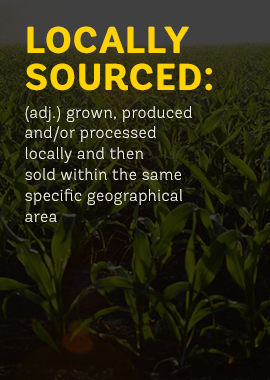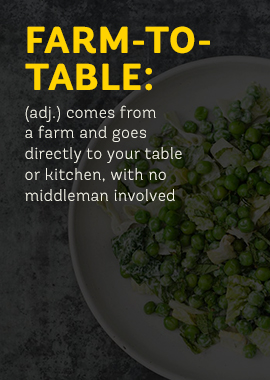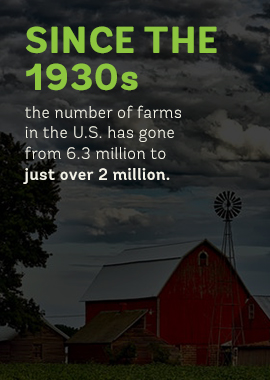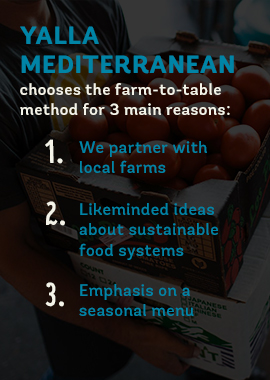Today, it’s easy to get overwhelmed with all the information and labels on food. For those looking to eat healthily, however, there is one label or phrase that is music to the ears — all-natural ingredients.
How Are All-Natural Foods Healthier for Us?
Eating foods with natural ingredients is much healthier than taking in artificial or processed foods. By definition, all-natural foods contain ingredients and nutrients that occur naturally, and they’re not stuffed with preservatives or other chemicals that we don’t need in our bodies.

It’s now easy to make meals at home from natural ingredients, but increasingly more and more people look for fresh food alternatives when dining out as well. Finding a restaurant that serves fresh food is a healthier option — and yes, it can even ease the guilty feelings sometimes associated with dining out.
Two buzz phrases that have popped up at restaurants in recent years are “farm-to-table” and “locally sourced.” The terms are similar and sometimes used interchangeably — when they perhaps shouldn’t.
For example, not all food that’s locally produced comes straight from a farm, and not all farm-to-table food comes from local sources — although most do. Both options are typically better for you than foods that aren’t locally sourced or farm-to-table, but even at that, these two sources have their differences.
So, what do these labels and the practices behind them really mean? Let’s look at a comparison of the two terms, and if there is a reason to choose food source one way or the other.
What Is Locally-Sourced Food?
 The phrase “locally sourced” is used freely these days, but just as the term indicates, it often means the food is grown, produced and/or processed locally and then sold within the same specific geographical area.
The phrase “locally sourced” is used freely these days, but just as the term indicates, it often means the food is grown, produced and/or processed locally and then sold within the same specific geographical area.
What most people might not know is that the word “local” can be defined in several different ways, which can make the phrase “locally-sourced food” or “locally sourced ingredients” somewhat murky. Was that locally-sourced produce grown and sold in the neighborhood? Or is it more a county-wide thing?
Some food manufacturers may even call their products “locally sourced” if they’re sold in the same state or region where they were produced. This broadness could mean at the other end of the state, or in a separate state entirely. The word local can be somewhat subjective, and there is no one agreed-upon or regulated definition that applies to locally-sourced food.
It can often come down to semantics, but there are ways to find out if food is truly “local.” Any respectable company that claims their products are locally sourced should have evidence to back up the claim: background information on the food’s packaging, a detailed overview of distributors listed on the company’s website, profiles of local farmers or a visible dedication to community support.
Food is considered locally sourced if it is produced and sold in the same local area. The definition of local is up to interpretation.
Is Locally-Sourced Food Good for You?
If a food or piece of produce is sourced locally, it doesn’t necessarily mean that it’s healthy or was made with all-natural or organic ingredients — two labels that you also want to take into consideration with your eating goals.
When it comes to health and nutrition, just because you’re eating locally-sourced food doesn’t automatically mean you’re eating better. The terminology means just that it was produced near your local area.
For example, if a local startup company produces snack foods and comes up with a version of the cinnamon bun, that item could technically be considered local if it uses locally-sourced ingredients. Still, location doesn’t make it any healthier. The item may have a shorter distance to travel to get to you, but it could still be filled with fat or sugar.
Put another way, the startup company’s new treat might be fresh and delicious because it didn’t have to travel far to get into your hands. Proximity though will do nothing to lower the calorie count and sugar content.

That’s not to say locally-sourced food can’t be healthy. As is the case with food from anywhere, it’s more important to look at the ingredients of a food to determine its health and nutritional value, not just if it was locally produced.
There are many good reasons to eat locally-sourced foods. If it’s local fruits, vegetables or other locally-sourced produce, the food will likely be fresher because it didn’t have to travel far. This proximity can have a positive impact on a food’s taste and nutritional value, because produce that travels a long distance before it makes it to your kitchen can lose flavor and nutrients over time.
The biggest beneficiary of locally-sourced foods is the local economy. When you buy food from those in your community — from your local bakery, a farmer’s market or a store — that money is often re-circulated into the local economy rather than finding its way to another part of the country or world. This is a good thing — it keeps local growers, food producer and businesses open. It can also promote local competition, which can lead to better products and lower prices.

How Can You Determine If a Food Is Locally-Sourced While Dining Out?
Some restaurants indicate if items are locally sourced right on their menus. If that information is not listed on the menu, ask your server if any or all the ingredients were sourced locally. If they don’t know, they can check with the manager or chef and find out for you.
If any or all your meal was not made with local ingredients, simply asking could indicate to the restaurant that there is some level of interest in seeing local items on the menu. If it becomes a repeat request from other guests like you, that interest could turn into a new service for the restaurant.
If you want to truly verify if a restaurant’s food really is locally sourced, that can take some investigation and follow-up effort. You could ask about the farmers or producers listed or mentioned and check up to confirm whether the food was produced locally or not.
What Makes a Food Farm-To-Table?
 Ingredients for nearly every food come from a farm, and every type of food can end up on your table. This reality doesn’t make every food farm-to-table, however. Rather, the phrase “farm-to-table” is a shortened version of saying a food comes from a farm and goes directly to your table or kitchen, with no middleman involved.
Ingredients for nearly every food come from a farm, and every type of food can end up on your table. This reality doesn’t make every food farm-to-table, however. Rather, the phrase “farm-to-table” is a shortened version of saying a food comes from a farm and goes directly to your table or kitchen, with no middleman involved.
At restaurants, a farm-to-table food is an item the business buys directly from a specific farm, rancher or fisher with which it has an established relationship. This sourcing can be attractive to restaurants because they know the quality and freshness of the food they’re getting. It can also help restaurants secure a steady supply of specialty items that might be otherwise hard to find.
When restaurants choose specific farms they’d like to work with, they can also control the quality of food that makes it on their menu. For example, if a restaurant wants all the beef on its menu to be grass-fed, they can easily verify this by visiting the supplying farm and seeing for themselves.

Why Is Farm-to-Table Good for You?
The freshness of farm-to-table food is one reason why it’s good for you. These items are often delivered within a day of being harvested, which maximizes both flavor and nutritional value. Would you rather eat an in-season apple you or an orchard owner picked from a tree the same day, or would you rather eat one that was shipped to you from across the country or sat in cold storage for months?
Another reason why farm-to-table can be a healthier option is the restaurant’s relationship with the farm. Buyers of farm-to-table foods, whether restaurants or consumers, can see that farm’s practices for raising crops and livestock, and whether any hormones or pesticides were used. This visibility can alleviate both health and ethical concerns when it comes to raising the plants and animals we consume.
The farm-to-table process is generally straightforward when it comes to produce, but it gets a bit trickier with meat and fish.
All meat sold in the U.S. is required to go through an inspection by the U.S. Department of Agriculture or a local or state agency. If a local livestock farmer doesn’t have immediate access to a facility where such inspections are conducted, this can mean the meat travels a good distance before it shows up in the kitchen or on the table. The time needed for this process could then affect both freshness and flavor.

Similar issues arise when it comes to farm-to-table fish. The seafood menu of a farm-to-table restaurant may be at the mercy of whatever local fishers were able to catch that day, meaning the menu might need to be fluid on a day-to-day basis. A restaurant’s “catch of the day” could vary from one day to the next.
Also, depending on what area of the country you’re in and what type of fish you’re looking for, there may be quotas in place to help prevent over-fishing. That means certain types of fish may be available only seasonally, if at all.
It can be a bit tougher to verify whether fish or seafood was sourced responsibly. It’s relatively easy for a restaurant owner to visit a farm and see for themselves how crops or livestock are treated and raised. It can be more challenging — but not impossible — to do the same thing when it comes to a fishing operation on the sea.
How Can You Determine If a Food Is Farm-to-Table While Dining Out?
As is the case with finding out if a restaurant’s foods were sourced locally, (visit yallamedi.com to find out more) it’s easy to find out if their food is farm-to-table. Many restaurants base their entire business plan on the farm-to-table concept, ensuring that every item on its menu can be defined in this manner.
If it’s not clear if a menu item is farm-to-table, there’s no harm in asking. Good restaurants like to be transparent about how and where their food is sourced, including whether it’s farm-to-table. If it’s not, they’ll at least know you have an interest in such food items.
It can help you to do your homework on the subject. That’s just what one reporter from The Tampa Bay Times in Florida did. By asking questions and talking with farmers, she eventually found that the sourcing claims of many so-called farm-to-table restaurants and locally sources food resturants were untrue. And although this is one example, it’s believed that misuse of the farm-to-table label is a widespread phenomenon.
How Are Locally-Sourced and Farm-To-Table Foods Alike?
 Locally-sourced and farm-to-table foods are not the same thing, but they can have some similarities.
Locally-sourced and farm-to-table foods are not the same thing, but they can have some similarities.
One similarity between locally-sourced and farm-to-table foods is that these items emphasize sustaining local horticulture systems and small-farm economics. By definition, locally-sourced food comes from local growers or manufacturers. That doesn’t have to be the case with farm-to-table foods, but it most often is since it’s easiest to abide by the farm-to-table concept when farms and restaurants are near each other.
Small farmers are no doubt hopeful the farm-to-table phenomenon will help boost an industry in gradual decline over the past 80-plus years. Since the 1930s the number of farms in the U.S. has gone from 6.3 million to just over 2 million, and farmers are an aging bunch. Perhaps the farm-to-table trend is the jumpstart the industry needs to thrive once again going forward. The movement could also mean a new, widely adopted best practice for the industry. If you’re passionate about contributing to sustainable farming and participating in the farm-to-table movement, explore farming job opportunities in on Jooble. These roles will offer you a chance to actively engage in revitalizing the farming industry and play a vital role in shaping the future of farming and supporting farm-to-table trends’ growth.
Another similarity between locally-sourced and farm-to-table items is an emphasis on foods that are clean from pesticides and other harmful chemicals. This lack of treatments isn’t always the case, but many small farmers believe in natural or organic farming methods. These practices can play a role in food safety and freshness.
With both labels, there often is little need for preservatives to help keep the food fresh for a longer time. Locally-sourced food doesn’t have far to travel, so there is no need to use preservatives to keep it fresh for the long haul. One of the biggest points of sourcing farm-to-table foods is often to choose farms that don’t use potentially harmful chemicals in the first place.
Pesticides are known to lead to a variety of health risks. Even lower dose exposure over an extended period has been associated with respiratory issues, skin conditions, depression, miscarriage, congenital disabilities, cancer and neurological conditions including Parkinson’s disease.
In the end, both locally-sourced and farm-to-table foods can be good options for finding healthy foods that are free of unwanted and unnecessary chemicals.
How Are Locally-Sourced and Farm-To-Table Foods Different?
While locally-sourced and farm-to-table foods share some similarities, there are some clear differences.
One difference is that locally-sourced food doesn’t always come directly from a farm. Depending on what the food item is, there can be other intermediaries involved before the food hits your table, such as a market, or a processing or packaging plant.
Similarly, not all locally-sourced foods are necessarily farm-fresh. While relatively rare, there is such a thing as processed or artificial foods that use local ingredients and are produced, processed and packaged locally. These foods could technically be considered locally sourced, but they are hardly farm-to-table.
Another difference between the two terms is the definition of “local.” There isn’t a regulated or mandatory definition of what the word local in “locally sourced” means, which can leave the term open to interpretation.

If you see the phrase “locally sourced” on a food item, you might assume that item came from your city, town or county. That’s not always the case. A food manufacturer may say its products are locally sourced if they’re grown or made in the same state. Others may go as far as to say their products are locally sourced when those items come from the next state over.
Most food providers that say their products are locally sourced may truthfully get them from local sources. Still, the opportunity for a loose interpretation of what the word “local” means leaves some room for false perception, or even deception.
Finally, the farm-to-table concept emphasizes a direct buying relationship between a restaurant and farm. That’s not necessarily the case when it comes to locally-sourced food — it could come from any farm or manufacturer, as long as they’re local. As we’ve discussed, that term can have a variety of meanings.
There are clear advantages in a strong and direct relationship between a restaurant and a farm. One of the most important is it’s easy for the restaurant owner to know how the farmer’s items — whether plants or animals — are grown and treated. Chefs and consumers alike can know if pesticides were used on produce, or whether the beef farmer’s cattle were grass fed. You’ll know if a fish was farmed or caught fresh in an ethical manner instead of through questionable means.
Why Yalla Mediterranean Chooses Farm-to-Table
 Knowing all of this, Yalla Mediterranean chooses the farm-to-table method for three main reasons:
Knowing all of this, Yalla Mediterranean chooses the farm-to-table method for three main reasons:
1. We Partner With Local Farms:
Yalla Mediterranean partnered with 13 farms in California for its produce. These partnerships keep the food as fresh as possible, and keeps local farmers in business.
Featured farms included Ratto Bros. in Modesto, which provided cilantro, dill, parsley and red cabbage. We also got garlic from Garlic Co. in Gilroy, potatoes from Greg Paul in Stockton, carrots from Grimmway Farms in Bakersfield, and red onions from Dalana Farms in Kettleman City.
2. Likeminded Ideas About Sustainable Food Systems:
Fresh food and the local economy isn’t the only reason Yalla Mediterranean deals with local farmers. We also do so to ensure we’re dealing with like-minded folks when it comes to views on natural foods and sustainability. We have specific standards for the foods we serve our customers, and the farmers we deal with do too.
We keep things local and we keep things sustainable by choosing to work with farmers who adhere to similar beliefs and practices where sustainability is concerned. After all, what’s the point of choosing which farms you get your food from if you don’t agree with how they grow their food in the first place?
3. Emphasis on a Seasonal Menu:
One of the cool things about the menu at Yalla Mediterranean is it’s always seasonal, which lends itself perfectly to the farm-to-table concept of fresh. That’s not to say that some of its most popular items aren’t on the menu year-round. But using seasonal ingredients gives us the opportunity to create exciting in-season dishes no matter what time of year it is.
Give Farm-to-Table a Try
If you’ve never tried farm-to-table food, now is a good time. To see what we offer, visit one of our seven locations: four in Northern California, three in Southern California.
You can also get farm-to-table in the comfort of your home by having your Yalla Mediterranean order delivered via DoorDash. Home delivery is available in Fremont, Dublin, Pleasant Hill and Walnut Creek in Northern California, as well as Burbank, Culver City and Seal Beach in Southern California. Delivery orders are often to your door in an hour or less.

Finally, to spread the farm-to-table love, have Yalla Mediterranean cater your next party or social event. We can cater any order with a day’s notice, and in some cases we can fulfill requests for same-day catering.
We can also accommodate any special dietary needs or allergies you or your guests might have — all you need to do is ask. Complimentary napkins, utensils and plates come with each order. We also include descriptor cards for each menu item so each unique dish is identified.
Once you give farm-to-table a try, you’ll be glad you did. You’ll taste and feel the difference. –

